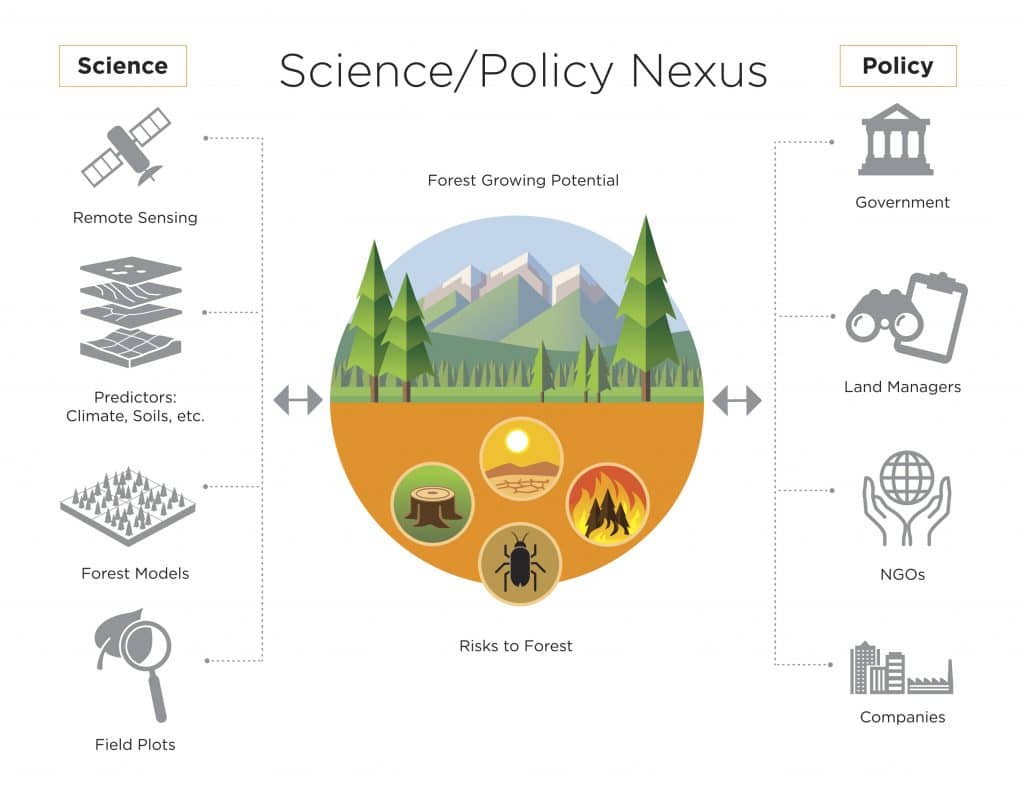Given the tremendous ability of forests to absorb carbon dioxide from the atmosphere, some governments are counting on planted forests as offsets for greenhouse gas emissions—a sort of climate investment. As with any investment, however, it’s important to understand the risks. If a forest goes bust—through severe droughts or wildfires, researchers say—much of that stored carbon could go up in smoke.
Professor Scott Goetz of Northern Arizona University’s School of Informatics, Computing, and Cyber Systems and associate professor Deborah Huntzinger of NAU’s School of Earth and Sustainability co-authored a paper published in Science finding that forests can be best deployed in the fight against climate change with a proper understanding of the risks to forests that climate change itself imposes.
“There have been optimistic assessments of how valuable forests could be in mitigating climate change over coming decades, but all of those have somewhat surprisingly overlooked or underestimated the factors that constrain forest carbon sequestration in the face of extreme temperatures, drought, fire and insect disturbance,” Goetz said. “This paper tempers that enthusiasm while also more realistically recognizing the potential of forests to remove massive amounts of heat trapping carbon dioxide from the atmosphere.”
A workshop held in 2019 gathered some of the foremost experts on climate change risks to forests. The diverse group, including Goetz and Huntzinger, represented various disciplines, including law, economics, science and public policy, and the workshop enabled the participants to start talking and come up with a roadmap. This paper, part of that roadmap, calls attention to the risks forests face from myriad consequences of rising global temperatures, including fire, drought, insect damage and human disturbance. It also serves as a call to action to bridge the divide between the data and models produced by scientists and the actions taken by policymakers.
“Terrestrial ecosystems absorb and store about a third of the carbon emissions human activities release each year, reducing the amount of carbon dioxide that accumulates in the atmosphere year after year,” Huntzinger said. “As a result, land ecosystems serve as a thermostat of sorts, regulating climate by helping to control carbon dioxide levels.”
Because of this, governments in many countries are looking to forest-based natural climate solutions that include preventing deforestation, managing natural forests and reforesting. Forests could be some of the more cost-effective climate mitigation strategies, with co-benefits for biodiversity, conservation and local communities.
But built into this strategy is the idea that forests are able to store carbon for at least 50 to 100 years.

Such permanence is not always a given, with the very real chance that the carbon stored in forest mitigation projects could go up in flames or be lost due to insect infestations, severe drought or hurricanes in the coming decades.
Forests have long been vulnerable to all of these factors but have been able to recover from them when they are episodic or come one at a time. However, the risks connected with climate change, including drought and fire, increase over time. Multiple threats at once, or insufficient time for forests to recover from those threats, can kill the trees, release carbon and undermine the entire premise of forest-based natural climate solutions.
“Not fully accounting for the range of climate- and human-driven risks to forests can result in an overestimation of the carbon storage potential of forest-based mitigation projects,” Huntzinger said. “Good science can better help identify and quantify risks to forest carbon stocks and lead to better policy decisions.”
The paper’s authors encourage scientists to focus increased attention on assessing forest climate risks and share the best of their data and predictive models with policymakers so that climate strategies including forests can have the best long-term impact. For example, the climate models that scientists use are detailed and cutting-edge, but aren’t widely used outside the scientific community, so policymakers might be relying on science that is decades old.
“There are at least two key things you can do with this information,” said lead author William Anderegg of The University of Utah. “The first is to optimize investment in forests and minimize risks. Science can guide and inform where we ought to be investing to achieve different climate aims and avoid risks.”
The second, he said, is to mitigate risks through forest management. “If we’re worried about fire as a major risk in a certain area, we can start to think about what are the management tools that make a forest more resilient to that disturbance.”
More research is needed in this field, and the collaborators plan to work toward answering those questions.
“We view this paper as an urgent call to both policymakers and the scientific community to study this more and improve in sharing tools and information across different groups,” Anderegg said.
Kerry Bennett | Office of the Vice President for Research




